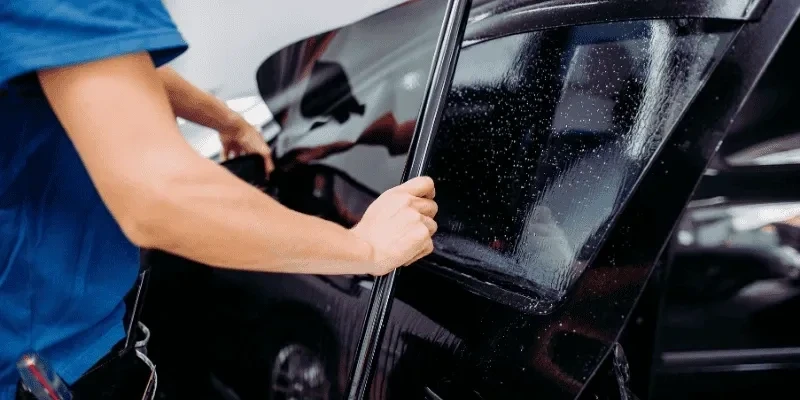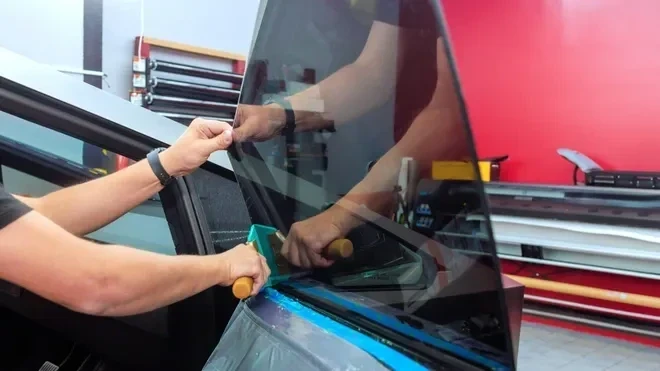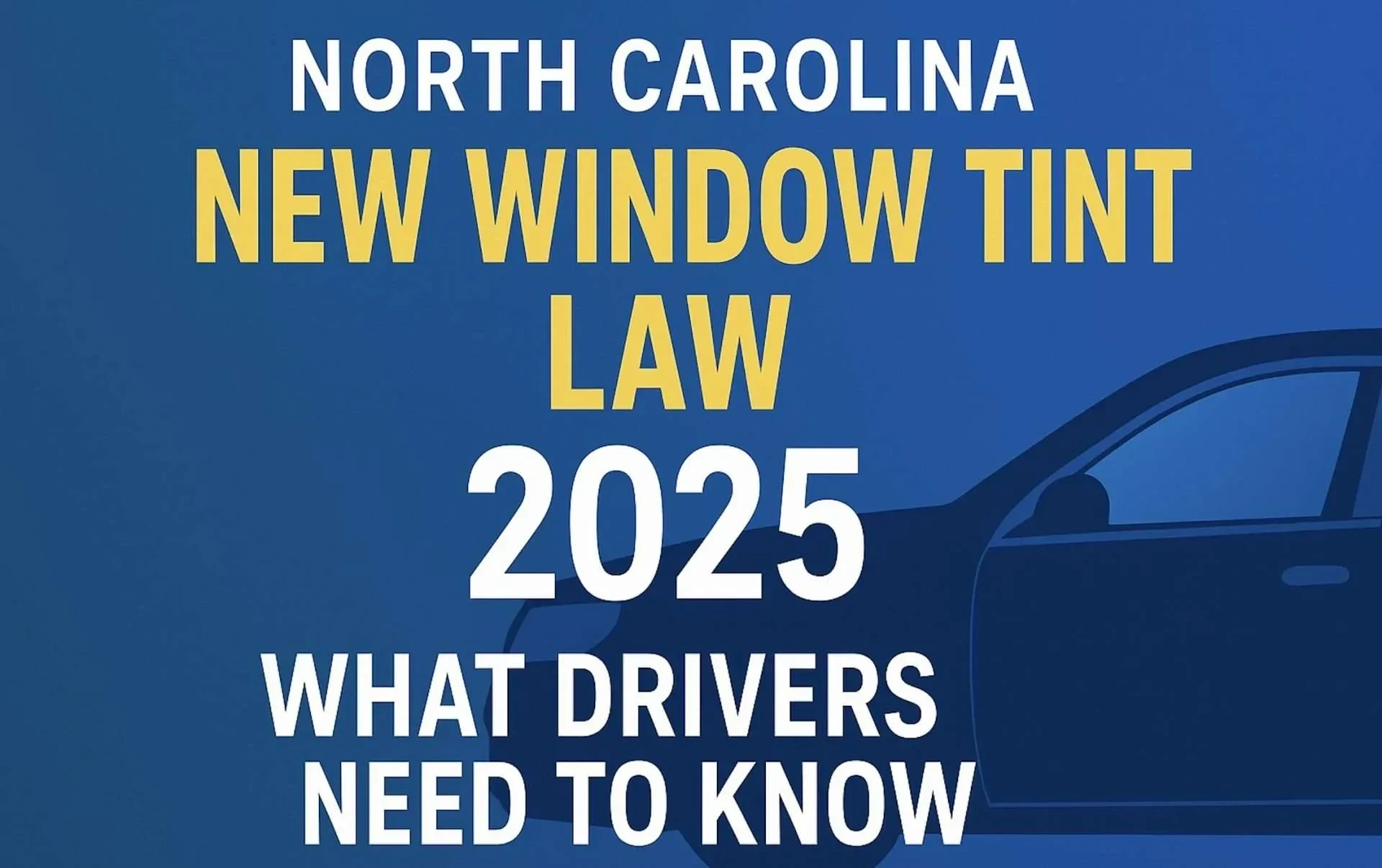
North Carolina Window Tint Law Changes 2025: What Every Driver Needs to Know
Understanding Senate Bill 43
Senate Bill 43, signed into law by Governor Josh Stein, makes several changes to North Carolina’s vehicle inspection and law enforcement interaction laws. The legislation aims to simplify vehicle safety inspections while establishing clearer protocols for interactions between drivers with tinted windows and law enforcement officers.
The bill represents a significant shift in how North Carolina approaches window tint compliance. Rather than relying on inspection stations to verify tint legality, the responsibility now falls directly on vehicle owners to ensure their window tint meets legal standards.
Major Changes Effective December 1, 2025
Elimination of Tint Inspections
As of December 1, 2025, there will no longer be a state inspection of vehicle window tint, meaning anyone who has tinted windows will save the ten-dollar inspection fee during their next vehicle inspection. This change removes the requirement for inspection mechanics to use light meters to measure window tint darkness during routine safety inspections.
Previously, any vehicle with aftermarket window tint underwent mandatory measurement during its annual safety inspection. This effectively eliminates the need for mechanics to use light meters to measure window tint darkness and removes the associated ten-dollar inspection fee for tinted windows.
The New Roll-Down Requirement
The most important behavioral change for drivers involves a new mandatory protocol during law enforcement encounters. If you have tinted windows, by law, you will be required to roll down your window when a law enforcement officer approaches, whether that’s on the driver’s side or the passenger side.
This requirement serves a critical safety function for law enforcement officers. The roll-down rule ensures that if you can’t see out and the light can’t come in, officers can see into the vehicle. Failure to comply with this new requirement could escalate what might otherwise be a routine traffic stop and may result in additional citations.
What Hasn’t Changed: Legal Tint Limits
Despite the elimination of inspection checks, it’s crucial to understand that the actual legal limits on window tint darkness and reflectivity remain completely unchanged. The law still applies to how dark window tint can be, requiring compliance with the 32% to 35% light transmittance standard.
Current Legal Tint Standards in North Carolina
Under North Carolina General Statute 20-127, the following standards remain in effect:
Windshield: Windshield tint is only allowed above the manufacturer’s AS-1 line or the top 5 inches, whichever is longer. This typically means you can only tint the top portion of your windshield where it won’t obstruct your forward vision.
Front Side Windows: Front side windows must allow at least 35% visible light transmission (VLT), meaning tint can’t be darker than 35% VLT, though a 3% variance is allowed so readings as low as 32% VLT may still pass.
Back Side Windows and Rear Window: The same 35% light transmission standard applies to back side windows and rear windows for passenger vehicles. Multipurpose vehicles like SUVs and vans may have different requirements.
Reflectivity: Window tint cannot exceed 20% reflectivity on any window. This prevents excessively mirror-like or reflective tints that could impair visibility for other drivers.
Prohibited Colors: Red, amber, and yellow tints are not permitted in North Carolina.
Medical Exemptions Still Available
North Carolina allows drivers with certain medical conditions to apply for a medical exemption permit, which authorizes a darker tint than normally allowed. Conditions such as photosensitivity, lupus, albinism, and other light-sensitive medical conditions may qualify for exemptions.
However, even with a medical exemption permit, drivers are not exempt from the new roll-down requirement. Even with a medical exemption, drivers must roll down tinted windows when law enforcement officers approach.
Medical exemption permits are issued for specific vehicles and remain valid for up to five years with proper doctor certification. The permits must be carried in the vehicle at all times. 
Common Misconceptions About the Law Changes
Myth: You Can Now Have Any Darkness of Tint
This is false and potentially costly. Many people mistakenly think that because the tint requirement for inspections has gone away, that it’s just the Wild West, however there is still a legal limit enforced. The removal of inspection checks does not eliminate legal tint limits.
Law enforcement officers can still pull you over if your tint appears too dark and can measure it using portable light meters. Drivers who are found to have their windows tinted too dark can receive a misdemeanor charge.
Myth: You Won’t Get Tickets for Illegal Tint Anymore
Just because window tint is no longer going to be inspected when you get your car inspected, you still have to comply with the law because you can still get a ticket. Law enforcement retains full authority to cite drivers for illegal tint during traffic stops.
The change simply shifts the point of enforcement from the inspection station to roadside enforcement. You’re still fully responsible for ensuring your tint complies with state law.
What This Means for Vehicle Owners
Benefits of the New Law
Cost Savings: Vehicle owners with tinted windows save the ten-dollar tint inspection fee during their annual safety inspection.
Faster Inspections: Without the need for tint measurements, the overall inspection process becomes quicker and more streamlined.
Reduced Hassle: Drivers no longer need to worry about tint inspection failures due to borderline measurements or meter calibration variations between inspection stations.
New Responsibilities
Self-Compliance: The responsibility for ensuring tint compliance shifts entirely to vehicle owners. You must verify your tint meets legal standards before installation.
Roll-Down Compliance: You must be prepared to roll down tinted windows immediately when approached by law enforcement during any traffic stop.
Continued Enforcement Risk: You remain subject to citations and fines if your tint exceeds legal limits, with potential consequences including misdemeanor charges.
Penalties for Non-Compliance
Violating North Carolina’s window tint laws can result in significant consequences:
Traffic Citations: Officers can issue citations for illegal tint during routine traffic stops. These citations carry fines and court costs.
Misdemeanor Charges: Failure to comply with window tint laws in North Carolina can lead to citations, fines, and orders to remove the tint. Repeated violations or extremely dark tint can result in Class 3 misdemeanor charges.
Mandatory Removal: Courts can order the removal of non-compliant tint as a condition of resolving the citation.
Insurance Implications: Traffic citations for equipment violations can potentially affect your auto insurance rates.
Roll-Down Violations: Non-compliance with the new roll-down requirement could escalate a routine traffic stop, potentially leading to additional charges or complications.
How to Ensure Your Tint is Legal
Professional Installation
Working with a reputable, professional window tinting service is the best way to ensure compliance. Professional installers understand North Carolina’s legal requirements and use calibrated equipment to ensure tint stays within legal limits.
When choosing a tinting service, ask about:
- Their familiarity with North Carolina’s current legal limits
- Whether they guarantee legal compliance
- The quality and type of film they use
- Whether they provide documentation of VLT percentage
Testing Your Existing Tint
If you already have tinted windows and are unsure whether they comply with the new standards, consider having them professionally tested. Many tinting shops offer testing services using calibrated VLT meters.
You can also purchase a portable tint meter to test your windows yourself, though professional-grade meters tend to be more accurate and reliable.
Documentation
Keep documentation related to your window tint, including:
- Receipts from professional installation showing VLT percentages
- Medical exemption permits (if applicable)
- Any manufacturer specifications for the tint film used
This documentation can be valuable if you’re ever questioned about your tint’s legality during a traffic stop.
Best Practices for Traffic Stops
To ensure smooth interactions with law enforcement under the new law:
Be Prepared: Keep your registration, insurance, and driver’s license easily accessible. If you have a medical exemption permit, keep it with your vehicle documents.
Roll Down Immediately: As soon as you notice an officer approaching your vehicle, roll down the appropriate window without waiting to be asked.
Be Courteous: Remain polite and cooperative. The roll-down requirement exists for officer safety, not to inconvenience drivers.
Keep Hands Visible: With the window down, keep your hands visible on the steering wheel until the officer requests documentation.
Explain Medical Exemptions: If you have a medical exemption permit, inform the officer promptly and provide the documentation.
Impact on the Tinting Industry
The law changes have significant implications for North Carolina’s window tinting industry. Professional tint installers must now take on greater responsibility for educating customers about legal limits and ensuring installations comply with state law.
Reputable shops view this as an opportunity to differentiate themselves from less scrupulous competitors who might be willing to install illegal tint. Quality shops emphasize legal compliance as part of their value proposition, protecting customers from future citations and legal problems.
Timeline and Implementation
The bill becomes effective on December 1, 2025, and applies to offenses committed on or after that date. This means:
Before December 1, 2025: Current inspection requirements remain in effect. Tint will continue to be checked during safety inspections using the existing procedures.
On and After December 1, 2025: Tint inspections are eliminated from safety checks, and the roll-down requirement takes effect. However, all legal tint limits remain unchanged.
This timeline gives both vehicle owners and law enforcement adequate time to become familiar with the new requirements and adjust their practices accordingly.
Related Changes in Session Law 391
The window tint changes are part of a broader piece of legislation that affects multiple aspects of vehicle regulation in North Carolina. Session Law 391 also includes provisions related to driver’s license validity extensions, electronic speed measurement in school zones, and various Department of Transportation operational changes.
Understanding the full scope of Session Law 391 can help drivers stay informed about multiple regulatory changes affecting North Carolina motorists.
Recommendations for North Carolina Drivers
Based on these changes, here are key recommendations:
Verify Current Tint: If you already have tinted windows, have them professionally tested to ensure they meet legal standards before December 1, 2025.
Choose Reputable Installers: If you’re planning to tint your windows, work only with professional shops that guarantee legal compliance and understand current North Carolina laws.
Keep Documentation: Maintain records of your tint’s VLT percentage and any medical exemption permits in your vehicle at all times.
Practice the Roll-Down: Make it a habit to roll down your windows immediately when stopped by law enforcement, even before the law takes effect.
Stay Informed: Monitor updates from the North Carolina DMV and Department of Transportation regarding implementation of the new requirements.
Don’t Test the Limits: Avoid installing tint at the absolute darkest legal limit. Give yourself some margin for error to account for measurement variations.
Conclusion
North Carolina’s window tint law changes represent a significant shift in how tint compliance is verified and enforced. While the elimination of mandatory inspections provides convenience and cost savings, it also places greater responsibility on vehicle owners to ensure their tint meets legal standards.
The legal limits for tint darkness and reflectivity have not changed. Window tint must still allow at least 35% light transmission on front side windows (with a 3% tolerance), and law enforcement retains full authority to cite drivers for non-compliant tint.
The new roll-down requirement emphasizes the safety considerations that have always been part of window tint regulations. By rolling down windows when approached by officers, drivers help ensure safe interactions while maintaining their right to have legally tinted windows.
As December 1, 2025 approaches, North Carolina drivers should take proactive steps to verify their tint’s legality, understand the new roll-down requirement, and work with professional installers who prioritize compliance alongside aesthetics and functionality.
Frequently Asked Questions (FAQs)
When do the North Carolina window tint law changes take effect?
The changes become effective on December 1, 2025, and will apply to offenses committed on or after that date. Until that date, current inspection requirements remain in effect.
Do I still need to follow the 35% tint limit after December 1, 2025?
Yes, absolutely. The law still applies to how dark window tint can be, requiring you to fall between that 32% to 35% light transmittance standard. The removal of inspection checks does not change legal tint limits.
Will I save money on my vehicle inspection?
Yes. Anyone who has tinted windows will save the ten-dollar fee during their next vehicle inspection since tint checks are no longer part of the standard safety inspection process.
What is the roll-down requirement?
If you have tinted windows, by law you will be required to roll down your window when a law enforcement officer approaches, whether that’s on the driver’s side or the passenger side. This is a new requirement that takes effect December 1, 2025.
Can I still get a ticket for illegal tint?
Yes. Just because window tint is no longer going to be inspected when you get your car inspected, you still have to comply with the law because you can still get a ticket. Law enforcement can still pull you over and cite you for non-compliant tint.
What happens if my tint is too dark?
Drivers who are found to have their windows tinted too dark can receive a misdemeanor charge. You may also be required to remove the illegal tint and could face fines and court costs.
Do medical exemptions still exist under the new law?
Yes. North Carolina allows drivers with certain medical conditions to apply for a medical exemption permit, which authorizes a darker tint than normally allowed. However, even with a medical exemption, you must comply with the roll-down requirement.
What if I don’t roll down my window when stopped?
Non-compliance with the new roll-down requirement could escalate a routine traffic stop. Failing to comply with a lawful officer request can result in additional charges and complications beyond any initial reason for the stop.
How dark can I tint my windshield in North Carolina?
Windshield tint is only allowed above the manufacturer’s AS-1 line or the top 5 inches, whichever is longer. You cannot tint the main viewing area of your windshield.
What is the 3% variance rule?
Front side windows must allow at least 35% visible light transmission, though a 3% variance is allowed so readings as low as 32% VLT may still pass. This accounts for measurement variations and film tolerances.
Will inspection stations still check tint at all?
The requirement for safety inspections to check window tinting is removed, eliminating the need for mechanics to use light meters to measure window tint darkness. Tint will not be part of standard safety inspections after December 1, 2025.
Can I tint my rear window as dark as I want?
No. The same 35% light transmission standard applies to back side windows and rear windows for most passenger vehicles. SUVs and multipurpose vehicles may have slightly different requirements, but significant restrictions still apply.
What colors of tint are illegal in North Carolina?
Red, amber, and yellow tints are prohibited in North Carolina. These colors can interfere with emergency vehicle lights and create safety hazards.
How can I verify my tint is legal?
Have your tint professionally tested with a VLT meter before December 1, 2025. Many professional tinting shops offer testing services. You can also purchase a portable tint meter, though professional-grade meters are more accurate.
Why was the law changed?
The changes appear designed to simplify vehicle safety inspections and provide a standard protocol for interactions between drivers with tinted windows and law enforcement officers. The law streamlines inspections while maintaining safety standards through the roll-down requirement.